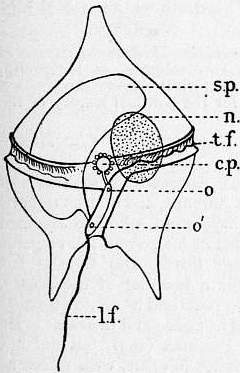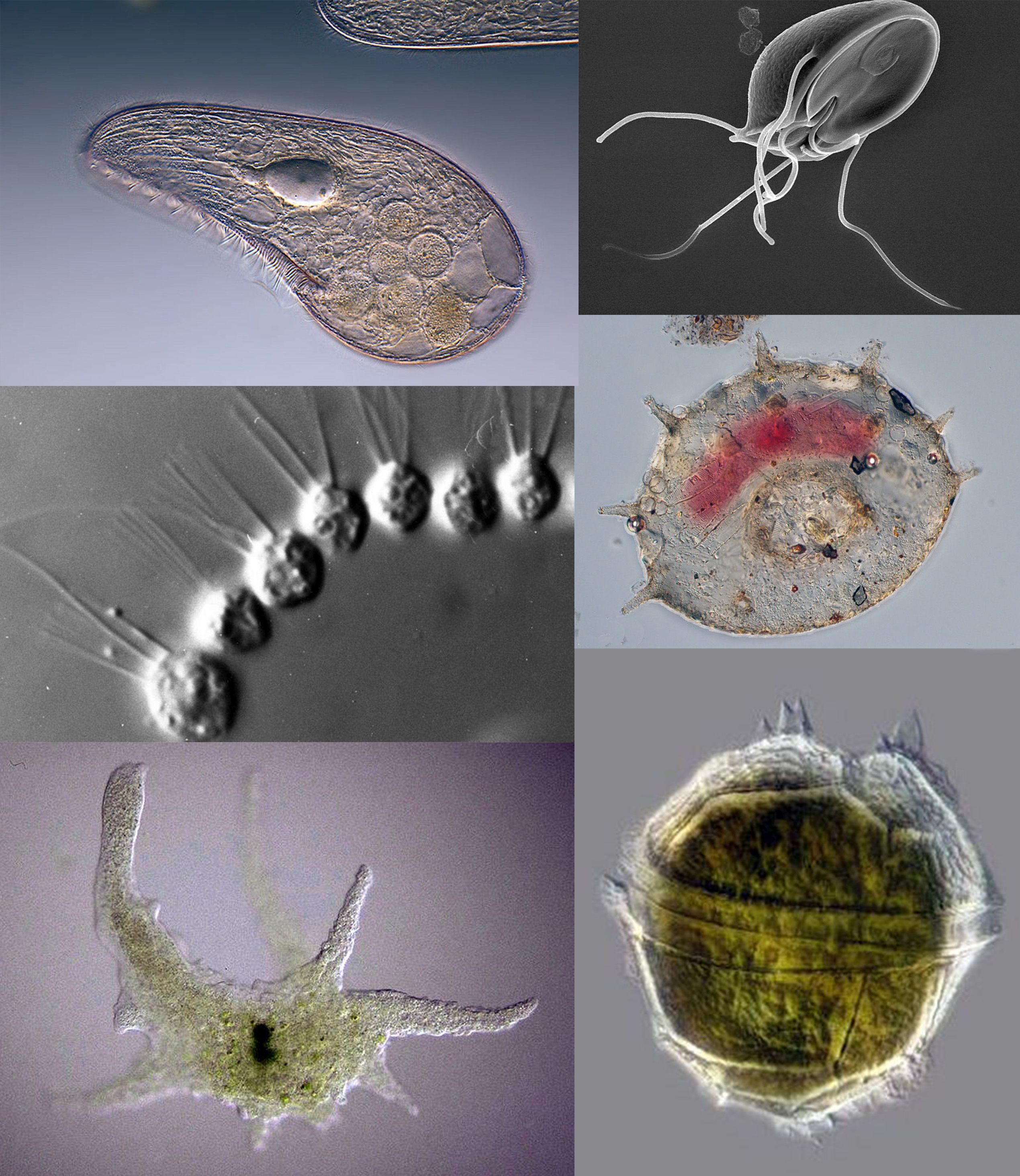|
Periplast
The periplast is one of three types of cell-covering of three classes of algae. The ''Cryptomonads'' have the periplast covering. The ''Dinophyceae'' have a type called the amphiesma, and the ''Euglena'' covering is the pellicle. Structure The periplast is a proteinaceous covering. It can be subdivided into an inner periplast and an outer periplast. Both of these components are variable in their composition. The inner periplast may be formed as a single sheet as in the Chilomonas paramecium, or as multiple plates of varying shape. The outer periplast surrounds the plasma membrane. The inner periplast below the plasma membrane may sometimes as in '' Komma caudata'' have a hexagonal arrangement of superficial periplast plates, and these are made up of sub-units. The superficial plates are lined up exactly with the inner plate and are surrounded by crystalline borders with the occasional rosette scale on the surface of the plates. A number of different periplast arrangements have be ... [...More Info...] [...Related Items...] OR: [Wikipedia] [Google] [Baidu] |
Cryptomonad
The cryptomonads (or cryptophytes) are a group of algae, most of which have plastids. They are common in freshwater, and also occur in marine and brackish habitats. Each cell is around 10–50 μm in size and flattened in shape, with an anterior groove or pocket. At the edge of the pocket there are typically two slightly unequal flagella. Some may exhibit mixotrophy. Characteristics Cryptomonads are distinguished by the presence of characteristic extrusomes called ejectosomes, which consist of two connected spiral ribbons held under tension. If the cells are irritated either by mechanical, chemical or light stress, they discharge, propelling the cell in a zig-zag course away from the disturbance. Large ejectosomes, visible under the light microscope, are associated with the pocket; smaller ones occur underneath the periplast, the cryptophyte-specific cell surrounding. Except for the class '' Goniomonadea'', which lacks plastids entirely, and ''Cryptomonas paramecium'' ( ... [...More Info...] [...Related Items...] OR: [Wikipedia] [Google] [Baidu] |
Algae
Algae ( , ; : alga ) are any of a large and diverse group of photosynthetic, eukaryotic organisms. The name is an informal term for a polyphyletic grouping that includes species from multiple distinct clades. Included organisms range from unicellular microalgae, such as '' Chlorella'', '' Prototheca'' and the diatoms, to multicellular forms, such as the giant kelp, a large brown alga which may grow up to in length. Most are aquatic and lack many of the distinct cell and tissue types, such as stomata, xylem and phloem that are found in land plants. The largest and most complex marine algae are called seaweeds, while the most complex freshwater forms are the '' Charophyta'', a division of green algae which includes, for example, '' Spirogyra'' and stoneworts. Algae that are carried by water are plankton, specifically phytoplankton. Algae constitute a polyphyletic group since they do not include a common ancestor, and although their plastids seem to have a single ori ... [...More Info...] [...Related Items...] OR: [Wikipedia] [Google] [Baidu] |
Dinophyceae
Dinophyceae is a class of dinoflagellates. Taxonomy * Class Dinophyceae Pascher 1914 eridinea Ehrenberg 1830 stat. nov. Wettstein; Blastodiniphyceae Fensome et al. 1993 orthog. emend.** Order Haplozoonales aplozooidea Poche 1913*** Family Haplozoonaceae Chatton 1920 ** Order Akashiwales *** Family Akashiwaceae ** Order Blastodiniales Chatton 1906 lastodinida Chatton 1906*** Family Blastodiniaceae Cavers 1913 ** Order Apodiniales *** Family Apodiniaceae Chatton 1920 ** Order Dinotrichales Pascher 1914 *** Family Crypthecodiniaceae Biecheler 1938 ex Chatton 1952 *** Family Dinotrichaceae Pascher 1914 ** Order Phytodiniales T. Christ. 1962 ex Loeblich 1970 inococcales Pascher 1914; Suessiales Fensome & al. 1993; Dinamoebales *** Family † Suessiaceae Fensome et al. 1993 *** Family Phytodiniaceae Klebs 1912 inococcaceae Fott 1960; Hemidiniaceae Bourrelly 1970; Borghiellaceae Moestrup, Lindberg & Daugbjerg 2009*** Family Symbiodiniaceae Fensome & al. 1993 ooxan ... [...More Info...] [...Related Items...] OR: [Wikipedia] [Google] [Baidu] |
Dinoflagellate
The dinoflagellates (Greek δῖνος ''dinos'' "whirling" and Latin ''flagellum'' "whip, scourge") are a monophyletic group of single-celled eukaryotes constituting the phylum Dinoflagellata and are usually considered algae. Dinoflagellates are mostly marine plankton, but they also are common in freshwater habitats. Their populations vary with sea surface temperature, salinity, and depth. Many dinoflagellates are photosynthetic, but a large fraction of these are in fact mixotrophic, combining photosynthesis with ingestion of prey ( phagotrophy and myzocytosis). In terms of number of species, dinoflagellates are one of the largest groups of marine eukaryotes, although substantially smaller than diatoms. Some species are endosymbionts of marine animals and play an important part in the biology of coral reefs. Other dinoflagellates are unpigmented predators on other protozoa, and a few forms are parasitic (for example, '' Oodinium'' and '' Pfiesteria''). Some dinoflagell ... [...More Info...] [...Related Items...] OR: [Wikipedia] [Google] [Baidu] |
Euglena
''Euglena'' is a genus of single cell flagellate eukaryotes. It is the best known and most widely studied member of the class Euglenoidea, a diverse group containing some 54 genera and at least 200 species. Species of ''Euglena'' are found in fresh water and salt water. They are often abundant in quiet inland waters where they may bloom in numbers sufficient to color the surface of ponds and ditches green (''E. viridis'') or red ('' E. sanguinea''). The species ''Euglena gracilis'' has been used extensively in the laboratory as a model organism. Most species of ''Euglena'' have photosynthesizing chloroplasts within the body of the cell, which enable them to feed by autotrophy, like plants. However, they can also take nourishment heterotrophically, like animals. Since ''Euglena'' have features of both animals and plants, early taxonomists, working within the Linnaean two-kingdom system of biological classification, found them difficult to classify. It was the question ... [...More Info...] [...Related Items...] OR: [Wikipedia] [Google] [Baidu] |
Pellicle (biology)
Protozoa (singular: protozoan or protozoon; alternative plural: protozoans) are a group of single-celled eukaryotes, either free-living or parasitic, that feed on organic matter such as other microorganisms or organic tissues and debris. Historically, protozoans were regarded as "one-celled animals", because they often possess animal-like behaviours, such as motility and predation, and lack a cell wall, as found in plants and many algae. When first introduced by Georg Goldfuss (originally spelled Goldfuß) in 1818, the taxon Protozoa was erected as a class within the Animalia, with the word 'protozoa' meaning "first animals". In later classification schemes it was elevated to a variety of higher ranks, including phylum, subkingdom and kingdom, and sometimes included within Protoctista or Protista. The approach of classifying Protozoa within the context of Animalia was widespread in the 19th and early 20th century, but not universal. By the 1970s, it became usual to require ... [...More Info...] [...Related Items...] OR: [Wikipedia] [Google] [Baidu] |
Chilomonas
''Chilomonas'' is a genus of cryptophytes, including the species ''Chilomonas paramecium''. Chilomonas is a protozoa (heterotroph). Chilomonas is golden brown and has two flagella A flagellum (; ) is a hairlike appendage that protrudes from certain plant and animal sperm cells, and from a wide range of microorganisms to provide motility. Many protists with flagella are termed as flagellates. A microorganism may have f .... References Cryptomonad genera {{Cryptomonad-stub ... [...More Info...] [...Related Items...] OR: [Wikipedia] [Google] [Baidu] |
Komma Caudata
''Komma caudata'' is a cryptomonad, and the only described species in the genus ''Komma'', although four or five more species may exist. Its cells are 4.5–5.5 μm wide by 7–10 μm long and bear two unequal flagella A flagellum (; ) is a hairlike appendage that protrudes from certain plant and animal sperm cells, and from a wide range of microorganisms to provide motility. Many protists with flagella are termed as flagellates. A microorganism may have f .... References Cryptomonads {{Cryptomonad-stub ... [...More Info...] [...Related Items...] OR: [Wikipedia] [Google] [Baidu] |
Euglenid
Euglenids (euglenoids, or euglenophytes, formally Euglenida/Euglenoida, ICZN, or Euglenophyceae, ICBN) are one of the best-known groups of flagellates, which are excavate eukaryotes of the phylum Euglenophyta and their cell structure is typical of that group. They are commonly found in freshwater, especially when it is rich in organic materials, with a few marine and endosymbiotic members. Many euglenids feed by phagocytosis, or strictly by diffusion. A monophyletic group consisting of the mixotrophic Rapaza viridis (1 species) and the two groups Eutreptiales (24 species) and Euglenales (983 species) have chloroplasts and produce their own food through photosynthesis. This group is known to contain the carbohydrate paramylon. Euglenids split from other Euglenozoa more than a billion years ago. The plastids in all extant photosynthetic species is the result from secondary endosymbiosis between a phagotrophic eukaryovorous euglenid and a Pyramimonas-related green alga. Structu ... [...More Info...] [...Related Items...] OR: [Wikipedia] [Google] [Baidu] |





